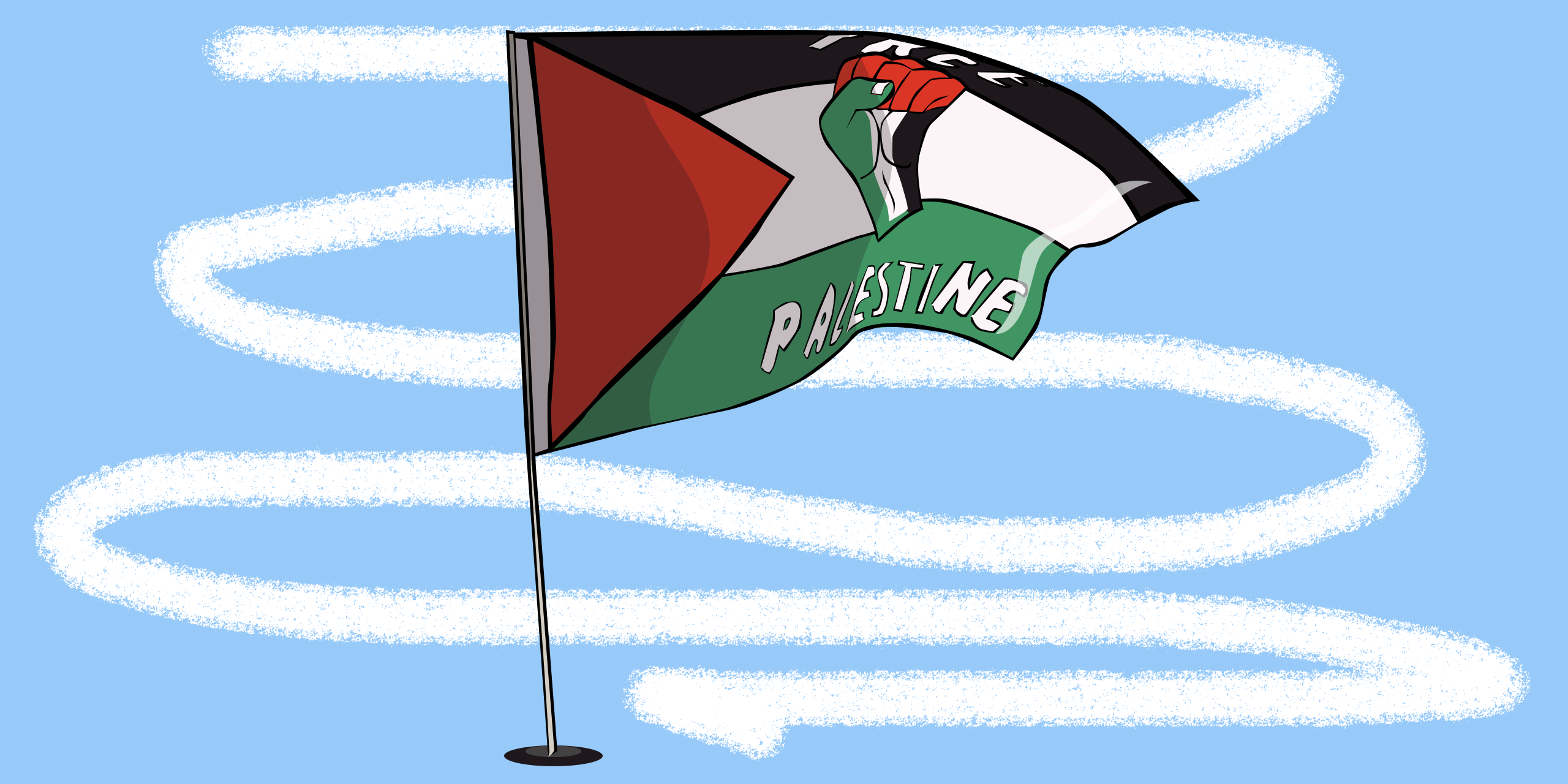*TW: Death and violence are mentioned.
All images taken by UCLA Radio Staff.
The violence that has ensued over the past few days is something not many would envision happening during their time at UCLA. But at the same time, it is not entirely unexpected given UCLA’s complicity in a narrative of power that subjugates the oppressed.
The ruthless and unmoving genocidal campaign committed by Israel against Gaza continues in the wake of university student protests across the U.S.. The voice of students around the world only grows louder amidst news that Israeli Prime Minister, Benjamin Netanyahu, vows to invade the Gaza city of Rafah, regardless if there is a cease-fire and hostage deal.
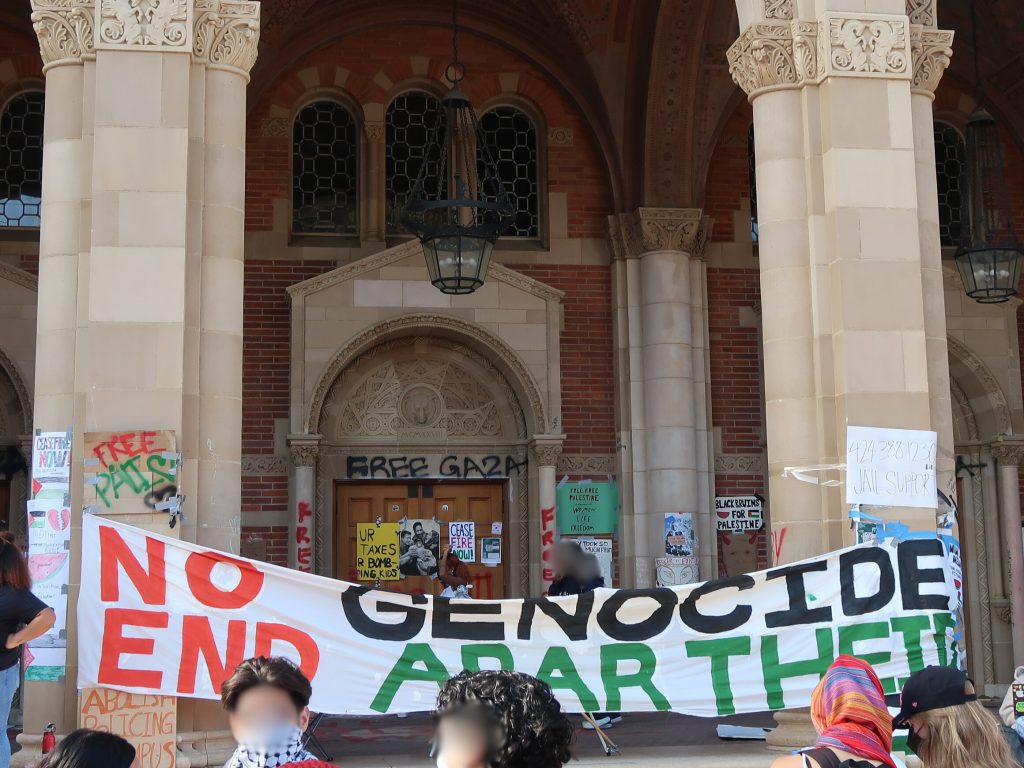
The Palestine Solidarity encampment at UCLA assembled on April 25th with the support of both students and faculty. The encampment demands UCLA to divest from BlackRock and other companies with holdings in the manufacturing of weapons being used to commit violence against Palestinians in Gaza and the West Bank. The convergence of the UC Divest Coalition, Students for Justice in Palestine (SJP), and Jewish Voice for Peace (JVP) has been paramount in organizing and supporting the student protestors. On a campus that already has a historical legacy of powerful protests, including the Vietnam War protest from 1967, the students at the encampment carry on a revolutionary torch.
On April 27th, however, this protest was challenged by Zionist counter-protestors, who raised over $50,000 to assemble a screen and speaker playing clips of horrific and violent depictions of the October 7th Hamas attack on Israel. Additional harassment included releasing mice in the center of the encampment, playing loud music next to the encampment all day, and even trying to break into the camp. Soon enough, however, they would succeed. At the same time that UCLA administration decided to condemn the encampment as a disruption to the campus community, Zionist counter-protest groups assaulted students in the encampment with pepper spray, metal and wooden poles, and fireworks. The counter-protestors also played a loud audio of a child crying, the same tactic reportedly used by the Israeli army to lure out and kill Palestinians. However, there was no protection from UCLA security or police for the students in the encampment. In fact, law enforcement simply stood on the quad as fireworks, pepper spray, and beatings rained down on the students. Many of us prayed that the violence would stop here.
The following night, LAPD used rubber bullets, flashbangs, smoke bombs, and physical force against the students who refused to abandon the encampment in solidarity with the Palestinians facing loss and death in Gaza. Over 130 reported students were arrested and bussed out to various detention centers and jails in LA. Many of us on campus are confused by the disproportionately brutal measures taken against student protestors as opposed to agitators. The veil of trust between the student community and the administration has been torn down as the following has been revealed: the University will prioritize its profits in a genocidal campaign over its students.
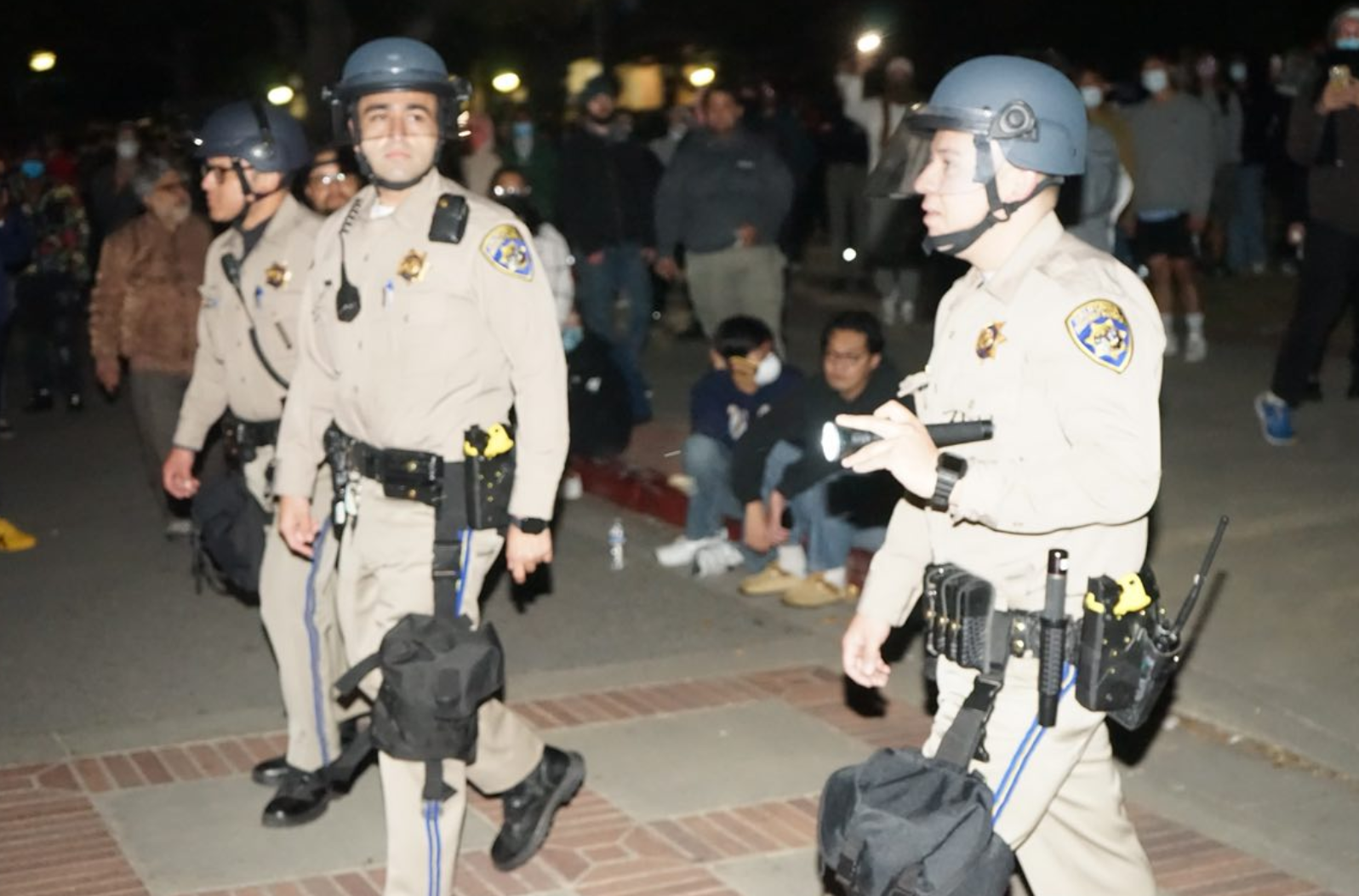
This violence against the student encampment is representative of a larger picture of violence that has been taking place in Gaza and other places around the globe for centuries. What has taken place on campus shows us that those in power scapegoat and recenter narratives as rationale to commit brutality. The invasion of Israel by Hamas on October 7th, and the subsequent killing of 1,200 people, was an act of extreme violence that has been bastardized rather than reconciled by Zionist campaigns. Disfiguring October 7th into a spectacle to rationalize genocide continues to be how those in power control the dominant narrative. As long as UCLA continues its investment in BlackRock and other companies enabling violence in Palestine, student activists will find themselves facing the same brutality that drives the Zionist narrative that violence is permissible against those supporting Palestine.
This narrative is clearest when we think about what happened on April 27th, when Zionist counter-protestors set up a large monitor playing a montage of attacks that happened on October 7th. Seeking to incite intense reactions from the Palestinian encampment while this monitor was depicting tragedy, many counter-protestors shouted inflammatory slurs at the encampment. Some of these include using “terrorist” against Black and Brown students, racial slurs for Black folk, and wishes for Hamas to commit violence against the students camping. The video portraying Hamas violence against Israeli civilians fueled unprovoked attacks on students, contradicting the very appeal to pathos it was seeking to make. The events that took place on October 7th were an act of terrorism, resulting in the disastrous death of 1,200 Israeli citizens and the capture of 250 Israeli hostages. However, these tragedies are portrayed in a vacuum that deliberately ignores the context in which this resistance took place.
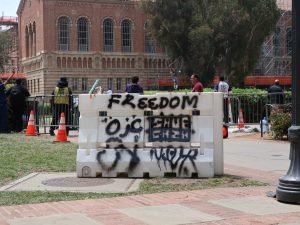
Israeli settler-colonialism that has been dispossessing Palestinian land has been taking place for decades. Palestinians live in a police state with constant surveillance, occupation, and police brutality. Since October 7th, over 35,000 Palestinians have been killed and almost 78,000 have been injured or hospitalized – not including West Bank casualties. A majority of the casualties have been women and children. Three-fourths of education and industry have been destroyed, alongside almost a third of hospitals and healthcare institutions. Palestinians have been attacked and killed in large numbers since the 1948 Nakba, or ethnic cleansing of Palestinians. These numbers reflect a concept of war that has been used by violent regimes throughout world history: total war. The destruction of people, property, and spirit is what fuels this tactic, and has been used by militaries as far back as Genghis Khan’s Mongol Empire. Cutting off electricity and water, suffocating borders, and destroying all commercial infrastructure are tactics that have been well-documented by the Israeli military forces in Gaza. This concept of total war constitutes an entirely disproportionate response to October 7th, a tragedy born out of severe oppression.
Once again, this pattern of a disproportionate response is not new. Severe ethnic cleansing of Armenians took place in Nagorno-Karabakh when the local majority Armenian population voted for the self-determination of an Armenian state in the wake of cultural oppression by the Azerbaijani government. There were bloody and traumatic pogroms committed against Azaerbaijani locals in response to the repeated denial of secession despite voting and passing a referendum for breaking away. Many Azerbaijanis were displaced as a result of the conflict during the 1990s. However, this displacement and violence that took place on disputed soil became the justification for Azerbaijan’s drone bombing campaign of Nagorno-Karabakh in 2020. With support from Turkey, a state that has ties to the Ottoman Empire’s genocide of Armenians in the early 20th century, Azerbaijan indiscriminately used heavy artillery and missile strikes, resulting in the evacuation and displacement of 3,000 Armenian civilians. The International Court of Justice ruled that Azerbaijani military forces were complicit in multiple war crimes including mass killings, tortures, and impeding traffic of ethnic Armenian passage outside of Nagorno-Karabakh – eerily similar to the blocking of Palestinian foot traffic out of Gaza by Israeli military forces. We must condemn the violence committed by the Armenian military against Azerbaijani citizens, but does this violence rationalize war crimes, especially when rooted in the genocidal intent to suppress the Armenian right to self-determination?
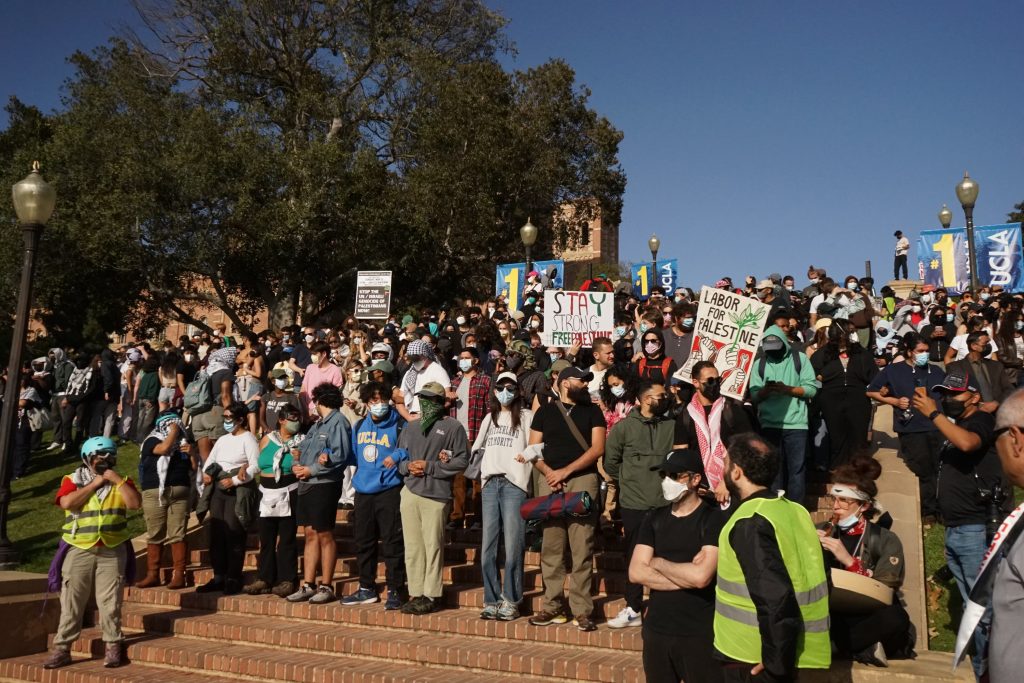
The spectacle of violence also plays an important role in the construction of the “terrorist”. Portraying oppressed peoples and their attempt at resistance as terrorists once again is used as justification for a disproportionately violent response. During World War II and the destruction of the Pearl Harbor naval base in Hawaii by Japanese forces, the dehumanization and “terrorist-ization” of Japanese Americans were necessary to justify both internment and dropping the atomic bomb on Nagasaki and Hiroshima. Witnessing the name-calling of students in the encampment, especially of Brown and Black students, was reminiscent of the dehumanization of others to rationalize subsequent attacks.
It is also important to note the role of power when it comes to perpetrating violence. To be in power is not necessarily to have a monopoly over violence, but to be able to commit violence permissibly. This is what enables oppressors to commit disproportionate violent retaliation. Backing by the UCLA administration and LAPD is what allowed the Zionists on our campus to perpetrate violence – this is power. The approval and funding from foreign agents is what allows the Israeli military to barrage and suffocate Gaza – this is power. Palestinian acts of violence as resistance to oppression, however, are not permissible – this is not having power. Violence in all of its forms is tragic, but it’s a greater tragedy to contort a genocide into a campaign of righteousness.
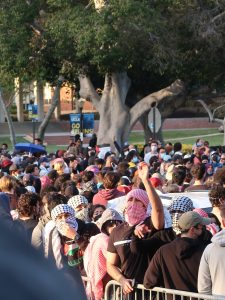
The capture of 250 Israeli hostages on October 7th, many of which have been released, was a tragedy. However, the Israeli government is holding 4,500 Palestinians captive, with what seems like no plan to release them. There are reports that Hamas plans to release the Israeli hostages if the Palestinian prisoners are released and if a cease-fire deal is negotiated. However, Netanyahu refuses to do either. If the interest of Israel was to obtain its hostages, then why does the state resort to violence instead of releasing its Palestinian hostages?
The concerns of many counter-protestors to the student encampment lie in the fact that Hamas is a terrorist group and students are sympathizing with an anti-semitic cause, making them terrorists themselves. But I urge those reading to again consider how “terrorist” is used in the narrative of violence. In the same way that the Yellow Peril was used in the depiction of East Asian immigrants as a danger to the West, students are tagged as dangerous to Western institutions as terrorists. This false equivalency between the actions of other organizations and governments to folks not complicit in violence is fear-mongering. The objective of the students in the encampment was clear – to get UCLA to divest from organizations funding an active genocide. When inflammatory language is used, such as “long live the intifada”, this rousing fear of terrorism and Islamophobia is wrongly leveraged into violence. In fact, the Arabic word “intifada” has been used by Arabic-speaking folk to describe the Warsaw Ghetto Uprisings, a powerful Jewish act of resistance against Nazi SS forces. These statements are expressions of self-determination and civil disobedience that have been bastardized by those who seek a narrative that justifies brutality.
The subversion of a tragedy like October 7th should not be taken lightly. It is the type of event where generations of collective trauma have unsurfaced, and healing cannot take place through genocide. The violence committed against civilians on October 7th should be condemned – but this condemnation cannot come at the price of the destruction of a people. We have seen history repeat itself time and time again. The same narratives that justify violence against Palestinians now justify violence against peaceful UCLA student protestors. The subversion of words, messages, and imagery into terrorism fuels a churning machine of hatred and victimhood. Chancellor Gene Block has expressed immense concern for the safety of the Jewish community on campus. What about the Jewish community organizers in the encampment, many of whom have experienced violence from police and counter-protestors? Now more than ever, the global eye is on UCLA, and history will severely judge the actions of those complicit in violence and total war.


